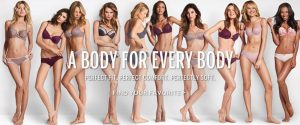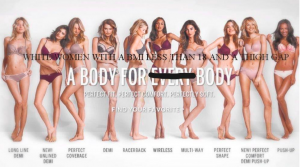
The original ad that is from Victoria Secret is representative of the hypersexuality of women and racial politics of women’s sexuality and it demonstrates consumerist and capitalist society in which Victoria Secret operates in. In the ad, the women who are represented all have little clothing on, only wearing lingerie. This signals their sexual availability, they are hypersexualized as it is demonstrated that the viewers have access to the women’s sexuality and their bodies. The bodies in the ad are all Caucasian, except for one. The one body that is not Caucasian still has lighter dark skin and has Caucasian features, thus embodying the hegemonic beauty standards that are promoted by Western media. The women are very skinny, but still have large breasts. The women all have long, wavy hair and virtually look identical as props in this ad. The ad is selling an “extremely limited model of sexuality,” as Michelle Smith in an article for the Conversation discusses (2013). Victoria Secret displays one type of sexuality, and it sells depending on which gender you identify with. If you are male, the ad is telling you that this is what is sexy and these women are what you find beautiful. If you are a women and you view this ad, it is telling you that this is what sexy is, and you do not look like that. This in part because the models are the ones who genetically are more slim and tall, but also due to dieting and photoshop behind the ad. Victoria Secret sells their product because women buy it in hopes that they will get the body that is being sold.
The ad limits the sexuality of women who do not fit this narrow view of what sexy is, and this is shown in the comparisons to how black women’s sexuality is discussed in the media. After Nicki Minaj’s music video for Anaconda, where her posterior is shown throughout the video, she was heavily slut-shamed for it. There was not the same reaction for artists who are Caucasian when they are naked in music videos (Lang 2014) or for the models in the Victoria Secret ad. Minaj commented on this unequal duality, making the comparison with a photo of Sports Illustrated models, saying “Angelic. Acceptable. Lol.” This is a poignant reaction to such racially different reactions to female sexuality. Even though Minaj is a successful hip-hop artist and likely has more agency in her career than Victoria Secret models, she is not given agency and ownership of her body in the public eye (Lang 2014).

My jammed version of the Victoria Secret ad addresses the narrow stereotype of white women’s sexuality that is controlled by the mainstream media. It allows viewers of the jammed ad to contrast what is being said in the ad, but also what is not being said in the ad. It speaks to bigger problems. My jammed version changes the tagline “a body for every body” to “a body for white women with a BMI of least than less than 18 and a thigh gap”. This encompasses many different issues that women face today. Women who view the jammed version may not be white, they likely have a BMI higher than 18, and will have thighs that touch. Victoria Secret is not known for caring about the bodies of the women that buy their lingerie, they do this through the use of their ‘angels’; their angels who are models who are extremely skinny but maintain large breasts. My jammed ad is anti-consumerism, as the philosophy behind the ad is capital-driven. I do not agree with what Victoria Secret is selling, and how they are selling it. Consumerism feeds into capitalism, and brands do everything in their power to get capital, even if that means selling the sexuality of women, reducing women to props, and leaving out women of colour and of sizes above 0. My ad is also a feminist statement, because all bodies matter and need to represented. It should not matter your skin colour, size, sexuality, etc. If these women want to create sexy images for themselves and put them on social media (Instagram especially), that would be different because the models would have agency in who is viewing that and how they are presenting themselves (Smith 2013). The women pose and their own image gets edited and photoshopped to produce an unrealistic image—they themselves are not as they appear in the ad. They do not have the control in their careers over how their image is produced. If capitalism runs on supply and demand, Victoria Secret creates both. This is unhealthy for society and therefore I attempt to challenge this in my ad.
Works Cited
Amy Lang “Nicki Minaj’s Unapologetic Sexuality is not a crisis,” Bitch Media. https://bitchmedia.org/post/nicki-minajs-unapologetic-sexuality-anaconda-video-feminism. August 28, 2014
Michelle Smith “Miley Cyrus, Sinéad O’ Connor and the future of feminism,” The Conversation.
https://theconversation.com/miley-cyrus-sinead-oconnor-and-the-future-of-feminism-18938. October 7, 2013
http://abcnews.go.com/Lifestyle/victorias-secret-controversial-perfect-body-slogan/story?id=26735138